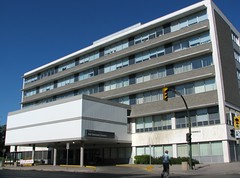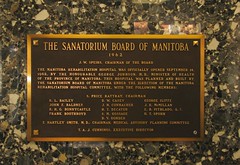© 2012, Christian Cassidy
Place: Rehabilitation Respiratory Hospital (HSC)
Address: 800 Sherbrook Street (Map)
Opened: September 14, 1962
Architect: Moody, Moore and Partners
Contractor: Baert Construction
Cost: $4.3 m
Manitoba's population was growing at such a fast rate in the 1950s that hospitals across the province routinely found themselves short of beds.
In Winnipeg, for instance, there were about 2,500 beds at its five general hospitals in 1959 - about a thousand more than there were at the end of the Second World War. That number was seen as sufficient for the city's population but hundreds of these acute care beds were being used to house chronically ill and convalescent patients.
The Duff Roblin government announced in 1958 a sweeping new hospital plan that would see new, modern hospital buildings constructed in Brandon and St. James and expansions to existing facilities at the Winnipeg General Hospital and in smaller centres such as Morris and Arborg.
More beds, however, would not solve the root problem, so the government turned the province's network of tuberculosis sanatoriums to get long-term patients out of acute care beds.
Address: 800 Sherbrook Street (Map)
Opened: September 14, 1962
Architect: Moody, Moore and Partners
Contractor: Baert Construction
Cost: $4.3 m
December 4, 1958, Winnipeg Free Press
Manitoba's population was growing at such a fast rate in the 1950s that hospitals across the province routinely found themselves short of beds.
In Winnipeg, for instance, there were about 2,500 beds at its five general hospitals in 1959 - about a thousand more than there were at the end of the Second World War. That number was seen as sufficient for the city's population but hundreds of these acute care beds were being used to house chronically ill and convalescent patients.
The Duff Roblin government announced in 1958 a sweeping new hospital plan that would see new, modern hospital buildings constructed in Brandon and St. James and expansions to existing facilities at the Winnipeg General Hospital and in smaller centres such as Morris and Arborg.
More beds, however, would not solve the root problem, so the government turned the province's network of tuberculosis sanatoriums to get long-term patients out of acute care beds.
Since 1910, the province funded a network of tuberculosis sanatoria that were administered by the Sanatorium Board of Manitoba, (now the Manitoba Lung Association.)
Thanks to advances in medicine and successful anti-TB public health campaigns, by the 1950s some of these facilities housed a fraction of the number of patients they were built for. The province and Sanatorium Board reached an agreement to expand the Board's mandate and converted a couple of hundred empty spaces at Ninette, Brandon, and Clearwater into long-term care beds.
There were bigger plans in store for the Central Tuberculosis Clinic located at the corner of Bannatyne Avenue and Olivia Street in Winnipeg.
Once Milton's Bakery, it was purchased by the Sanatorium Board in 1929 and converted into a drop-in clinic, administrative headquarters, and TB research repository. (Winnipeg's main TB in-patient facility was the city-run King Edward Hospital.)
The province and Sanitarium Board reached an agreement to demolish the old clinic and build in its place the $4.3m Manitoba Rehabilitation Centre which would be dedicated to the treatment and recovery of the physically disabled and those suffering from diseases such as arthritis.
It would be the first such facility in Western Canada.
January 21, 1960, Winnipeg Free Press
The Central TB clinic was moved to temporary space at the General Hospital over the Christmas holidays of 1959 to allow for the demolition of the old clinic building.
In May 1960, the contract for the construction of the new hospital was awarded to local firm G. A. Baert Construction.
A groundbreaking ceremony took place on June 6, 1960 and construction began immediately after. The building process appears to have gone smoothly with one exception. In June 1961, two workers fell to the ground while pouring concrete on the exterior apron of the fifth floor. Both survived but were seriously injured.
With construction underway, attention turned to hiring staff for the new centre.
In May 1960, Dr. Leslie Truelove was appointed chief of staff for the hospital and the director of the U of M’s new School of Occupational and Physical Therapy, (the name was changed to the School of Medical Rehabilitation in 1962).
Born in Sheffield, England, Truelove specialized in internal medicine and rehabilitation and was a research fellow at the General Hospital in Edinburgh.
The following year, Joy Huston was appointed chief occupational therapist. Born in China to British missionary parents, she studied in London and was the chief occupational therapist at the Rehabilitation Clinic at the Royal Northern Hospital in London.
Marjorie Spence was then appointed head of the physical therapy department. Born in Winnipeg, she trained in Eastern Canada and served as a Lieutenant of Physiotherapy in the Royal Canadian Army Medical Corps in Europe during World War II.
Google Street View
Moody Moore and Associates designed the 12,608 m² (135,711 sq ft) facility that is made up of three interconnected buildings.
Most prominent is the six-storey Manitoba Rehabilitation Centre that faced Sherbrook Street.
Its top three floors contained wards for up to 158 in-patients. The third floor was home to the U of M's School of Medical Rehabilitation. The second floor housed medical offices, an auditorium, and a cafeteria that extended beyond the face of the building to create a covered entrance along Sherbrook Street. The main floor contained outpatient clinics and the Sanatorium Board's administrative offices.
West of the main tower was the narrow, four-storey, 20-bed Respiratory Hospital, (also known as the D. A. Stewart Centre), which also contained tuberculosis and other outpatient clinics.
A single-storey building extends south of the building, along McDermot Avenue, and behind the main hospital creating an open air courtyard between the two. This housed the occupational, physical, and hydro therapy treatment areas.
The basement level serving all three buildings includes a parkade (which sits under the courtyard, a central kitchen, and the entrance to a 97.5 m (320 foot) tunnel to the General Hospital. An engineering ans prosthetics lab was added in 1963.
September 15, 1962, Winnipeg Free Press
The first section of the centre to open was the Respiratory Hospital / D. A. Stewart Centre / TB outpatient clinic on January 3, 1962.
By April, occupational and physical therapy began on the main floor.
Other areas opened over the summer and on September 14, 1962, J. W. Speirs, chair of the Sanatorium Board, and provincial health minister George Johnson officially opened the centre.
In 1971, a provincial government report recommended that the various hospitals clustered around Sherbrook and Bannatyne, all of which had independent boards, be amalgamated into a single "Health Sciences Centre" to allow for better planning of services and infrastructure.
The necessary legislation was passed and the HSC came into being on February 1, 1973.
The Sanatorium Board, publicly at least, said it had no hard feelings about losing control of the hospital that it ran for over a decade. The move would allow it to continue to fund research and gear up for its next decades-long campaign: the fight against smoking.
After the takeover, the board's offices relocated to Dublin Avenue. The name change to the Manitoba Lung Association came in 1975.
February 5, 1973, Winnipeg Free Press
Not all of the hospitals reacted the same way to the forced amalgamation.
On the first day of the "Health Sciences Centre" era, someone at the Children's Hospital, which was founded in 1909 and fought hard against the merger, flew its flag at half-mast.
Related:
Winnipeg's Rehab Hospital turns 50 ! West End Dumplings
Canada's role in fighting tuberculosis Manitoba Lung Association
Our History Health Sciences Centre
Health Sciences Centre Archives Museum Virtual Museum
A history of the Manitoba Lung Association Manitoba Lung Association













No comments:
Post a Comment